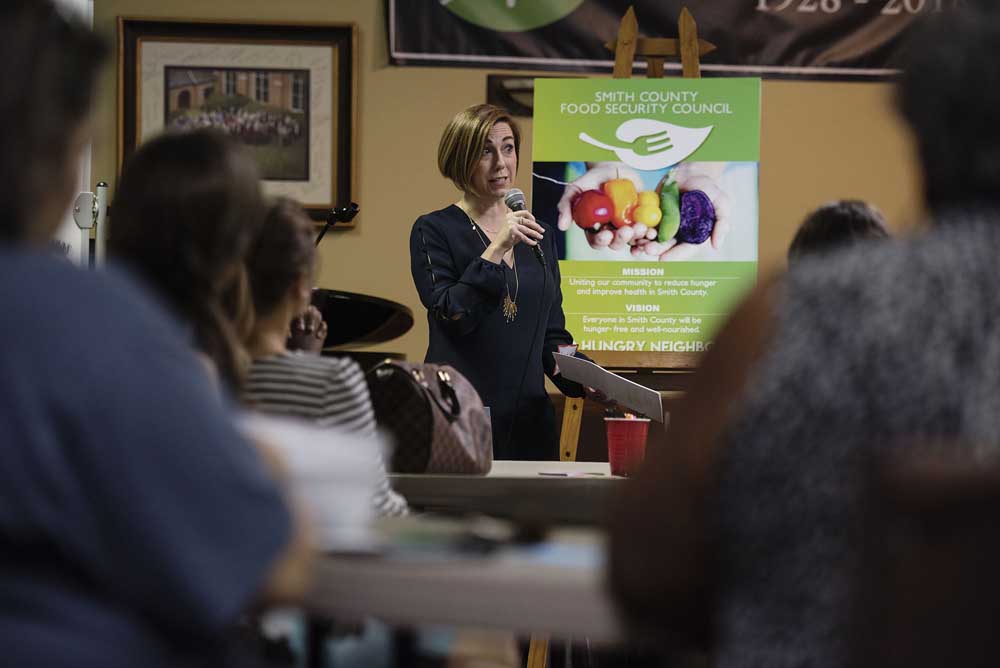Food insecurity in Smith County the focus of new hunger council
Published 7:58 pm Monday, August 13, 2018

- Pediatrician Valerie Smith speaks at the first community-wide meeting of the Smith County Food Security Council on Monday, August 13, 2018 at Marvin United Methodist Church in Tyler. The new group aims to bring together people from across the community to reduce hunger and improve health. (Sarah A. Miller/Tyler Morning Telegraph)
Tyler nurse Celeste Fisher grew up eating one meal a day because her family could not afford to buy food.
Her dad usually got the most to eat because he worked a manual labor job and needed the energy.
“It wasn’t until the fifth-grade year that I realized breakfast and lunch were normal parts of the day,” she said. “I got those at school, but in the summer we had supper only.”
Close family friends stepped in to help, but memories of the constant yearning for something to eat are always close at hand.
She’s not alone, it seems.
Children and adults are going hungry across East Texas, prompting a network of concerned medical experts and stakeholders to push for change and improved health for all.
Several dozen people showed up Monday for the first meeting of the Smith County Food Security Council to share input and suggestions on how to turn things around.
Monday’s meeting at Marvin United Methodist Church attracted representatives from nonprofits, civic organizations, churches and other groups.
The overall goal of the gathering — the first of many to come — is to not just reduce hunger, but also to improve the overall health of not just children, but residents of all ages.
“Mostly, I want to collect your ideas,” said organizer Dr. Valerie Smith, a pediatrician for St. Paul Children’s Foundation. “At St. Paul, we’ve spent the last 30 years serving families and operating a food pantry … our last year has taken a really deep dive in food security.”
About 20 percent of households in Smith County don’t have enough food to eat, a number that amounts to about 1 in 5 adults and 1 in 4 children.
“That’s 43,000 adults and 13,000 children,” Smith said. Schoolchildren are missing lunch, contributing to a variety of issues such as anemia, high cholesterol, behavior problems, poor academic performance and depression, she added.
A recent study by the East Texas Human Needs Network of 400 families revealed about 31 percent regularly skip meals and 47 percent routinely choose between purchasing food and paying bills.
The council’s leadership team is composed of representatives from St. Paul, the Northeast Texas Public Health District, Christus Trinity Mother Frances, East Texas Human Needs Network, East Texas Food Bank, UT Health East Texas, Texas A&M Agrilife Extension, WIC (Women Infants and Children), Amerigroup, Tyler Independent School District and Children’s Defense Fund.
Certain focus groups plan to address critical needs areas such as health care, urban agriculture and food pantries, all of which contribute to well-being.
Tecora Smith, who oversees WIC for NET Health, sees families from 20 counties, the equivalent of 24,500 people.
“Our moms have a desire to provide nutrition to their children,” she said. “The question is — how?”
The numbers are frightening, she said, citing a recent instance in which a new mother was discharged from the hospital after giving birth and stopped by the WIC center with her infant as it was closing for the day.
“She needed formula,” Smith said. “She didn’t have any at home … we see hunger at a community level.”
East Texas Food Bank’s Donna Spann said the problem is not limited to young adults raising children.
“About 22.4 million meals were given out to food-insecure families,” she said, noting the Northeast Texas area ranks high in hungry families compared with other areas in the state.
Efforts to combat hunger come on the heels of a report that indicates people in Northeast Texas are sicker and dying earlier than their counterparts in other areas of the state and even the United States.
The 2016 Health Status of Northeast Texas examined the growing problem of food insecurity experienced by an estimated 1.5 million people residing in the 35-county study area.
Within that region, about 28.9 percent of children under 18 don’t get enough to eat, compared with the rest of Texas at 27.4 percent and United States at 21.4 percent.
The Health Status Report was compiled by the University of Texas System, in partnership with UT Health Northeast, now part of the UT Health East Texas.
To learn how to get involved, contact St. Paul Children’s Foundation at 903-531-9455.
Check out our gallery of photos from the event on focusinon.me.
TWITTER @ TMT _ Jacque







